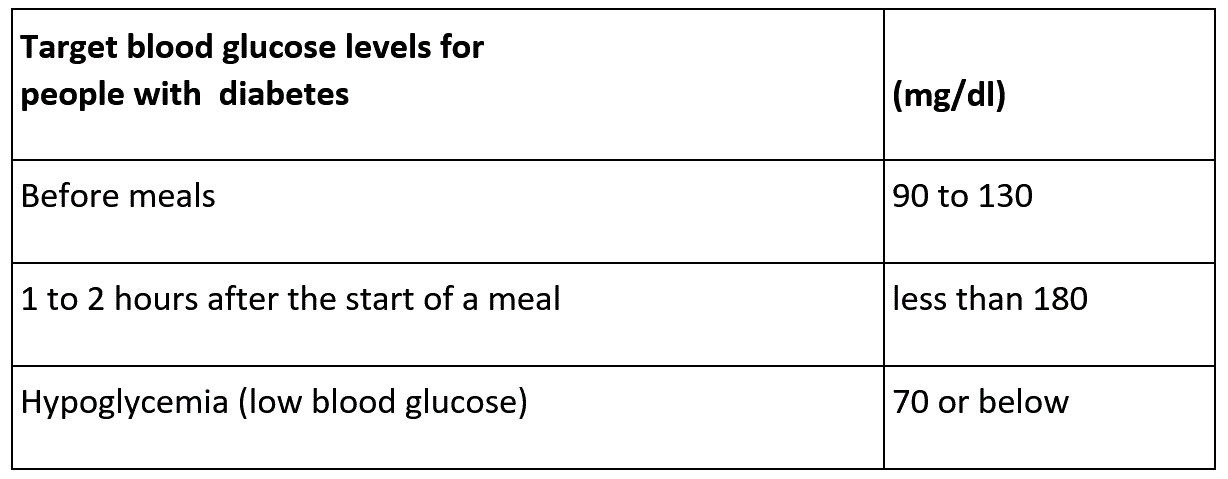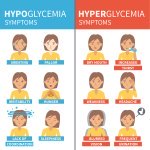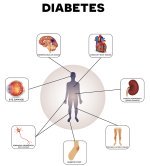Dangerous Blood Sugar Levels
Identifying Dangerous Blood Sugar Levels: Low and High
Let’s talk about how to identify dangerous blood glucose levels. In a nutshell, normal blood sugar levels are between 70-100mg/dL after fasting and before meals. Normally, blood sugar levels are less than 140 mg/dL two hours after eating a meal.
In general, dangerous blood sugar levels those that are less than 60-70 mg/dL or over 180 mg/dL at any time. More about this later. Meanwhile, let’s talk a little about what blood sugar actually is since many people don’t know.
Blood sugar level another name for blood glucose levels. Some people picture blood sugar as granulated white sugar circulating around in their arteries. It isn’t. Sugar cane is a natural source of sucrose, or table sugar. Glucose is a carbohydrate and is the most important simple sugar in human metabolism Glucose is made during photosynthesis from water and carbon dioxide, using energy from the sun. Commercially, it is commonly manufactured from cornstarch. Glucose is one of the primary molecules which serve as energy sources for plants and animals.
Most of us relate high or low sugar level to a genetic disease. In reality, while some individuals do have a genetic propensity to develop type 2 diabetes, it really is a disease caused by modern lifestyle and eating habits. Type 1 diabetes is thought to be genetic, but even then, modern medical science may be actually causing some percentage of the cases due to modern medical practices which hyper-activate the immune system early in life. Regardless of whether they are diabetic or not, everyone can benefit from having more stable blood sugar levels. At the same time, truly dangerous blood sugar levels are typically only experienced by diabetics who are not eating properly or administering their insulin properly.
What do you mean by blood sugar levels?
Blood sugar, also known as blood glucose, is the sugar (glucose) in your plasma that comes from the food we consume. The normal concentration of glucose in the blood is about 0.1%, but it becomes much higher in persons suffering from diabetes. The expression ‘blood sugar’ is essentially conversational and used to designate glucose which is a category of sugar that is present in the bloodstream and changed into energy. The glucose goes into the circulation from the digestive system where it is used to feed the cells of the body.
Insulin, a hormone secreted by the pancreas shuttles glucose out of the blood and into the cells of the body. Blood sugar levels increase when we consume nutrients, which triggers the release of insulin so that the cells consume the glucose and the blood sugar levels remain normal.
What happens when you have dangerous blood sugar levels?
Most people without diabetes do not need to worry about dangerous blood sugar levels. Their body is handling sugar properly to keep their blood glucose in a healthy range.
Diabetics and pre-diabetics do need to worry about dangerous blood sugar levels.
And everyone needs to keep their blood sugar levels as stable as possible. For most people with diabetes, a healthy range is between 90 and 130 mg/dl before meals and less than 180 mg/dl at one to two hours after a meal (see chart below).
Diabetics need to keep track of this because they often take medication or inject themselves with insulin. Too much insulin can cause dangerously low blood sugar levels. Not enough can result in dangerously high blood sugar levels.
A doctor can give you specific instructions about how and when to test your blood sugar. You can also read all about Blood Sugar Testing here.
If you are worried you may be experiencing blood sugar problems, read about Diabetes Warning Signs

Hypoglycemia (low blood sugar)
Sometimes blood sugar levels fall excessively low. This is called hypoglycemia. Hypoglycemia can occur when someone is not eating a healthy diet, goes long periods of time between meals, takes a lot of insulin or diabetes medicine, or exercises more than normal. Dangerous blood sugar levels like this include the following warning symptoms:
- Fast heartbeat
- Sweating
- Dizziness
- Shaking
- Feeling anxious
- Hunger
- Vision problems
- Weakness or feeling very tired
- Headache
- Feeling irritable
General Guidance for Treating Acute Hypoglycemia
If you have any of the symptoms of hypoglycemia, check your blood glucose. If the level is 70 or less, have one of the following quick acting sources of sugar right away:
- 3 or 4 glucose tablets
- 1/2 cup of any fruit juice
- 1 cup of milk
- 1/2 cup of a regular (not diet) soft drink
- 5 or 6 pieces of hard candy
- 1 tablespoon of sugar or honey
After 15 minutes, check your blood glucose again to make sure your level is 70 or above. Repeat these steps as needed. Once your blood glucose is stable, eat a meal or have a snack that includes plenty of protein and healthy fat.
You can avoid hypoglycemia by eating meals every few hours, taking your diabetes medicine, and testing your blood glucose regularly. Checking will inform you whether your glucose level is going down. You can then eat a protein and healthy fat rich meal or snack, to increase your blood glucose in a sustained way and eliminate blood sugar swings.
There is a life-saving treatment called glucagon that can be given by injection in an emergency. Glucagon is a hormone made in the pancreas that raises glucose levels. Glucagon helps to opposite the indications of hypoglycemia. Glucagon will not harm a person, but occasionally may cause vomiting or nausea.
If you are worried you may be experiencing low blood sugar problems, read this article about the Symptoms of Low Blood Sugar. You may also want to read up about what to eat to prevent hypoglycemia.
Hyperglycemia (high blood glucose)
If your blood glucose stays over 180, it may be too high. High blood glucose indicates that you don't have sufficient insulin in your body. High blood glucose, or "hyperglycemia," can occur if you miss taking your diabetes medicine, eat a lot or don't get enough exercise. This is called hyperglycemia. It can also occur because of stress or illness. The symptoms are:
- Great thirst
- Having to urinate frequently
- Dehydrated skin
- Hunger
- Indistinct vision
- Sleepiness
- Wounds heal slower
For diabetics, having an infection, being sick, or under stress can also make your blood glucose too high. That's why it's very important to check your blood glucose and keep taking your diabetes medicines when you're sick.
If you're very thirsty and tired, have blurry vision, and have to go to the bathroom often, your blood glucose may be too high. Very high blood glucose may also make you feel sick to your stomach.
If your blood glucose is high much of the time, or if you have symptoms of high blood glucose, call your doctor. You may need a change in your diabetes medicines, or a change in your meal plan.
It's important to treat hyperglycemia as soon as you notice it. If you fail to treat hyperglycemia, a condition called ketoacidosis could happen. Ketoacidosis develops when your body doesn't have enough insulin. Without insulin, your body can't use glucose for energy. As a result your body breaks down fats to use for energy.
Just to be clear, ketoacidosis, or too much blood sugar is very different from ketosis a term that refers to fat burning metabolism (as opposed to glucose burning metabolism). Many people get confused about this.
If you are worried you may be experiencing high blood sugar problems, read this article about High Blood Sugar Levels as well as about the Top Three Symptoms of Hyperglycemia. Worried your blood sugar may be too high? Learn natural strategies for Lowering Blood Sugar.
Symptoms of Ketoacidosis
Ketoacidosis is life-threatening and needs immediate treatment. Symptoms include:
- Shortness of breath
- Breath that smells fruity
- Nausea and vomiting
- A very dry mouth
Talk to your doctor about how to handle this condition
Normally, a great way to lower your blood glucose level is by exercising. Though, if your blood glucose is below 240 mg/dl, check your urine for ketones. If you have ketones, do NOT exercise.
More Information
More information to help you avoid dangerous blood sugar levels:



New! Facebook Comments
What do you think? Share your thoughts below...